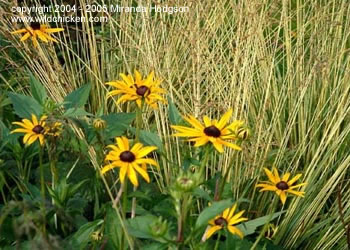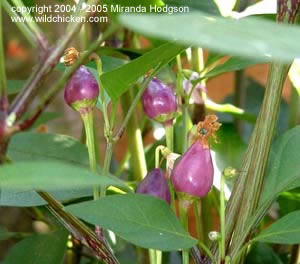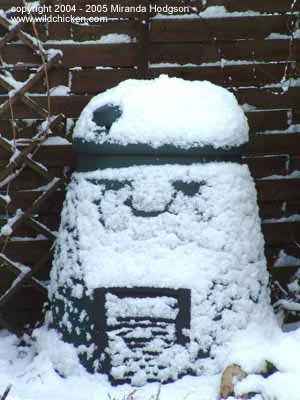Feb 21st 2005 - Rocotos and compost
It’s been snowing for a few days and I haven’t been into the garden except to knock snow off the plants. Some of them were quite heavily burdened by the weight and looking very droopy. Most of the evergreen grasses, on the other hand, had faired better and wore their covering with much more style. A light dressing of snow on their arched blades sets them off a treat and emphasises their elegance.
"...In summer it carries long arched stems of purplish flowers and looks very graceful."
A visit to a local nursery last week and I found two grasses I’ve been looking for – Molinia caerulea ‘Variegata’, to put with Rudbeckia fulgida var. sullivantii ‘Goldsturm' and Uncinia Rubra. The Molinia is clump forming, about 1m tall, and has green and cream striped leaves. In summer it carries long arched stems of purplish flowers and looks very graceful. Uncinia rubra is a sedge rather than a true grass. It forms small evergreen clumps of dark red-bronze foliage.

Although not fully hardy I will risk it here, where the soil is so free draining. Good drainage in winter can make all the difference to the survival of a plant of borderline hardiness; wet roots can kill them off quickly. I’m not sure where to put it yet, but think it could go in the front garden, either close to the Molinia or near to a bronze Carex. As it is short and slow growing, care must be taken that it doesn’t get overwhelmed by something more vigorous.
One disappointment was not being able to find any species Digitalis in any of the nurseries. Everything is in new shades of yellow and peach. Where has Digitalis purpurea gone?
On Sunday the heated propagator came out of its corner to be cleaned and put into service. I’ve been waiting for this moment with some anticipation.
"...The first two we tried last year and found them to be juicy and full of flavour; Aunty Madge’s is an unknown and came from the HDRA’s heritage seed library."
As soon as January begins I start thinking about what vegetables to sow and get terribly impatient. They could be started earlier but there is so little light here in January and early February that it isn’t worth bothering. First in are tomatoes and chillies – tomatoes Brandywine, Tigerella and Aunty Madge’s. The first two we tried last year and found them to be juicy and full of flavour; Aunty Madge’s is an unknown and came from the HDRA’s heritage seed library as a ‘lucky dip’. I think that probably means it’s something they have too much of and need to give away. The catalogue doesn’t mention flavour but says it is a prolific producer and good for salads, soups, paste or casseroles.

The chillies for this year are Purple, Rocoto and Bolivian Rainbow. Purple produces small, round, very hot fruits which start off almost black and turn to dark red as they ripen; Rocoto’s fruit are larger and look a lot like orange sweet peppers but are actually very hot indeed. Bolivian Rainbow is the absolute favourite, both for flavour and style of growth. Compact plants produce masses of small, pointed, upright fruits which start out dark purple, then go through white, yellow and orange before turning red. You get all colours on the plant at the same time. Their flavour is excellent and the heat is average to hot.
"...There was a bit of a disaster with drying them and I fear I may have made a dreadful mistake."
I’m slightly concerned about the Rocoto. There was a bit of a disaster with drying them and I fear I may have made a dreadful mistake. After last year’s sopping wet summer and low light levels, the Rocoto didn’t ripen on the plants so I cut them off and brought them indoors, where they were strung on cotton thread and hung in a window. Hanging there, they started to ripen quite well and as soon as they looked ready I put the string in the coolest part of the airing cupboard to finish off.
But – oh dear – when I came to extract the seeds most of them had a furry covering of dried mould on them. One seemed to be okay and I used the seeds from that fruit. If all goes well this year, the seeds will be extracted as soon as the fruit is ripe and not left inside to go off. Still, you live and learn.
As Rocoto is a perennial (Capsicum pubescens) and tolerates lower temperatures, it can be over-wintered in much the same way that you’d do with a tender Fuchsia. I have one plant left from last year which I’ve been coddling through the cold dark days. Looking at it yesterday, it’s just starting to put out new shoots so maybe all will be well. If it starts to grow well in the spring, it may be possible to take some cuttings and increase the stock that way.
"...I was so horrified at what I found that I didn’t take care with opening the others and ripped them to pieces with bare fingers."
The most vexing thing about these Rocoto seeds was that whilst I cut open the first fruit very carefully, I was so horrified at what I found that I didn’t take care with opening the others and ripped them to pieces with bare fingers. That resulted in burning fingers for the rest of the day and evening which no amount of washing alleviated. There must be an antidote for chilli burns – if anyone has one, please do drop me a line!

A funny thing – I came downstairs on Sunday morning to put the kettle on and was gazing sleepily out of the window when I saw that our compost bin had developed a new look. It must be something to with how it’s been moulded but the way the snow had blown against it, stuck and then melted slightly had resulted in a smiling face. How very odd, and what a treat. There could be a lesson here: compost and from time to time your compost bin will smile at you.
© Copyright Miranda Hodgson 2005